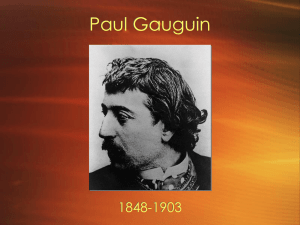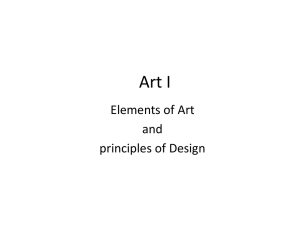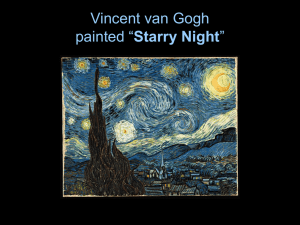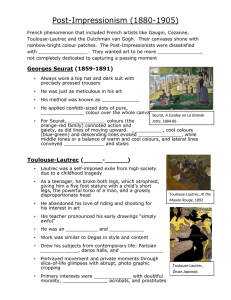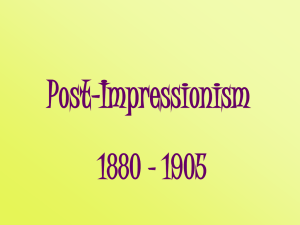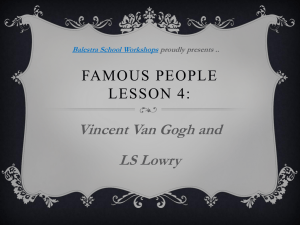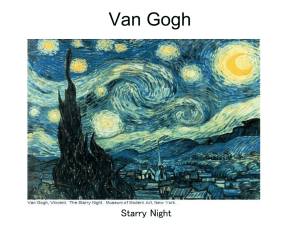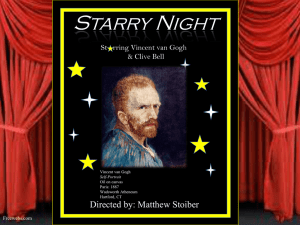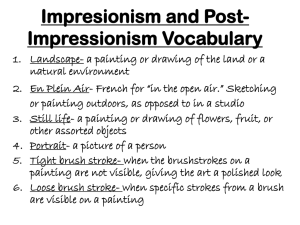Paul Gauguin - Saint John`s High School
advertisement
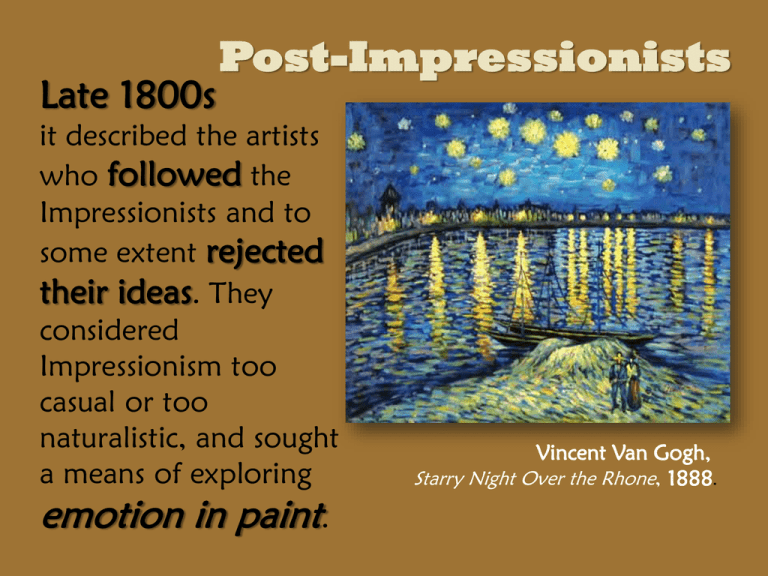
Late 1800s Post-Impressionists it described the artists who followed the Impressionists and to some extent rejected their ideas. They considered Impressionism too casual or too naturalistic, and sought a means of exploring emotion in paint. Vincent Van Gogh, Starry Night Over the Rhone, 1888. Toulouse-Lautrec Post-Impressionism Disabled poster artist known as one of the first Graphic Designers Paul Cezanne Large block-like brushstrokes; Still lifes, Landscapes Vincent Van Gogh Distrurbed painter of impasto and bright, vivid colors George Seurat Founder of Pointillism Paul Gauguin Rejected Urban Life and chose Tahitian women as subject Auguste Rodin Bronze sculptor; inspired by Michelangelo. “The Thinker” Henri de Toulouse-Lautrec Because of his disabilities, he focused only on his art. He lived in the tawdry part of Paris with outcasts, entertainers and prostitutes who became his models. Henri de Toulouse-Lautrec Because of his disabilities, he focused only on his art. He lived in the tawdry part of Paris with outcasts, entertainers and prostitutes who became his models. Henri de Toulouse-Lautrec ” At the Moulin Rouge” 1895 Henri de Toulouse-Lautrec Inspired by Degas. His work had an almost caricature look. He popularized the poster as an art form Toulouse-Lautrec ” At the Moulin Rouge” 1895 Henri de Toulouse-Lautrec La Goulue, 1891. Degas Henri de Toulouse-Lautrec Jane Anril 1893. Shepard Fairey Toulouse-Lautrec Ambassadeurs: Aristide Bruant 1892. Paul Cezanne Son of a wealthy banker Post Impressionists did not have much commercial success. Cézanne's art was misunderstood and discredited by the public during most of his life Saw himself as a failure Left many works unfinished and destroyed others By the time of his death in 1906 he attained legendary status. Paul Cezanne, Still Life with Apples, 1890. Condenses themes of apples to structured abstraction Paul Cezanne, Still Life with Apples, 1890. The structure of the apples supports his belief that the natural world can be “reduced to a cone, a sphere, and a cylinder” Paul Cezanne, Still Life with Peppermint Bottle, 1894 Paul Cezanne, Card Players, 1892. Paul Cezanne, The Bathers, 1890-91. Paul Cezanne, Mont Saint Victoire, 1885. Vincent Van Gogh •Greatest Dutch artist since the Baroque period •Didn’t begin painting until he was 30 and died before he was 40. •A life of poverty and despair with bouts of madness Van Gogh, The Potato Eaters, 1885. started out with a dark palette and evolved to bright, intense colors •He was supported by his brother, an art dealer Van Gogh Sunflowers, 1888. Vincent Van Gogh, The Night Cafe, 1888. Vincent Van Gogh The Night Cafe, 1888. Vincent Van Gogh, Starry Night, 1889. He paints energy! Hokusai, The Great Wave, 1828 Vincent Van Gogh Self-Portrait with Felt Hat, 1887-88. Van Gogh Portrait of Dr. Gachet, 1888. Vincent Van Gogh, Bedroom at Arles #3, 1889. Edvard Munch “The camera cannot compete with the brush and the palette so long as it cannot be used in heaven or hell…" Edvard Munch The Scream Oil and pastel on cardboard 1893. Edvard Munch Norwegian painter -A moody guy. -Called his paintings his children. -He expresses modern anguish- extreme emotions. -Forerunner of EXPRESSIONISM- astyle that portrayedemotions through distorting form and color The Scream Edvard Munch -Forerunner of EXPRESSIONISM a style that portrayed emotions through distorting form and color Kandinsky, 1915 Edvard Munch, The Dance of Life, 1899-1900. Tension….eerie Paul Gauguin •Extensive world travel •Lived as apainter in Tahiti •Known for arbitrary use of color •Arrogant, obnoxious •Inspired by Japanese prints Gauguin, Self Portrait, 1888. flattens his picture plane much like the Japanese printmakers. Tahiti. He used exotic people to represent biblical characters. Madonna scene Paul Gauguin Ia Orana Maria (Hail Mary), 1891. He felt himself a visionary His self portrait alludes to his divinity. (halo, apples, snake) Paul Gauguin Self Portrait With Halo, 1889. Tahitian Women on the Beach, 1891 Paul Gauguin, Woman With a Flower, 1891 George Seurat •No line •Interested in the science of color theory- how does the eye perceive color? •POINTILLISM •He felt he could take Impressionism to a higher level using Optical Mixture Stare at the red dot on the next slide for a slow count to 10… Sunday Afternoon on the Island of La Grande Jatte, 1886. George Seurat, The Circus, 1891. Seurat, Le Pont de Courbevoie, 1886-87. Seurat, The Bathers, 1884. Auguste Rodin Artist who resurrected the art of bronze sculpture work, as seen in: •The Gates of Hell •The Thinker •The Kiss Auguste Rodin, Burghers of Calais, 1886. Auguste Rodin, The Thinker (or The Poet) 1880 Auguste Rodin, The Gates of Hell 1880-1917 Inspired by Michelangelo Auguste Rodin, The Kiss c1880 Art Nouveau an international style of art, architecture and design ( glass, furniture, jewelry) A response against industrialization that peaked in the beginning of the 20th century. Art Nouveau highly-stylized, flowing, curvilinear designs often incorporating floral and other plantinspired motifs. Louis Comfort Tiffany, Glass Vase, 1910. Victor Horta Hotel Tassel, 1890s. 1st Art Noveau building Art Nouveau Gaudi Spanish Architect Building was considered sculptural as well. biomorphic, or organically-shaped. a rejection to the coldness of the geometric industrial world Casa Milà, 1907. Gustav Klimt, Kiss 6’x6’. 1908 The couple “blends “ in with the design. They are submerged by the intricate gold pattern Aubrey Beardsley Salome with the Head of John the Baptist, 1893 He was an illustrator who was denounced for decadence
